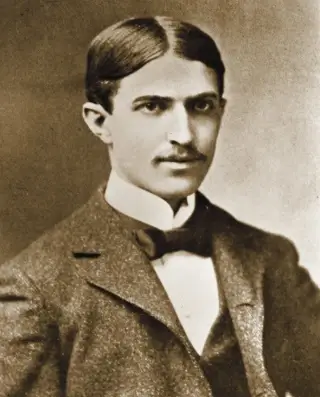Biography of Stephen Crane

| date | place | |
|---|---|---|
| born | November 01, 1871 | Newark, New Jersey, U.S |
| died | June 05, 1900 | Badenweiler, German Empire |
Stephen Crane, born on November 1, 1871, in Newark, New Jersey, was a prominent American poet, novelist, and short story writer. He was the youngest of fourteen children in a devout Methodist family. His father, Jonathan Crane, was a Methodist minister who died when Stephen was only eight years old. This loss deeply affected him and shaped much of his early life and writing. Raised primarily by his strong-willed mother, Crane was often sickly as a child, suffering from various ailments that persisted into adulthood. Despite these challenges, he displayed remarkable intelligence and creativity from a young age, teaching himself to read before the age of four and writing his first poem at nine. Crane attended Claverack College and briefly enrolled at Syracuse University but left before completing his degree in 1891 to pursue a career in journalism and literature. He moved to New York City, where he lived in a boarding house for medical students while working as a freelance journalist. During this time, he became fascinated with the Bowery district—a neighborhood that had transformed from wealth to poverty—and wrote "Maggie: A Girl of the Streets" (1893), a novel that explores the harsh realities of urban life through the tragic story of a young woman. This work is one of the first examples of American Naturalism and reflects Crane's deep empathy for the downtrodden. Crane's most famous work, "The Red Badge of Courage" (1895), is a psychological exploration of fear and bravery experienced by a young soldier during the Civil War. The novel received critical acclaim for its realistic portrayal of battle and human emotions, despite Crane having never served in the military himself. His other notable works include short stories such as "The Open Boat," which recounts his harrowing experience surviving a shipwreck while en route to report on the Cuban War of Independence. This story exemplifies Crane's ability to blend vivid imagery with profound psychological insight. In addition to novels and short stories, Crane published several poetry collections, including "The Black Riders" (1895) and "War Is Kind" (1899), which showcase his innovative use of free verse and explore themes such as war, nature, and existential despair. Crane's personal life was marked by tumultuous relationships and financial difficulties. In 1892, he began an affair with Lily Brandon Munroe, a married woman estranged from her husband. Despite his frail health—he suffered from tuberculosis—Crane's charm attracted Munroe; however, her family's disapproval ultimately led to their separation. In 1897, Crane survived a shipwreck while traveling to Cuba to cover the Spanish-American War. His dramatic escape garnered media attention and solidified his reputation as a war correspondent. He later traveled with Cora Taylor, a former brothel owner who became his partner; although they could not marry due to legal constraints at the time, they maintained a long-term relationship until his death. Despite his literary successes, Crane struggled with financial instability throughout his life. He often lived beyond his means and faced mounting debts. His health deteriorated due to tuberculosis compounded by malarial fever contracted during his time in Cuba. Crane died on June 5, 1900, in Badenweiler, Germany, at the young age of 28. His legacy endures through his innovative contributions to American literature and his profound exploration of human nature amidst adversity. Stephen Crane's poetry is characterized by its innovative use of free verse and vivid imagery, often exploring profound themes such as the human condition, existential despair, and the nature of God. His first collection, "The Black Riders and Other Lines" (1895), showcases his early rebellious spirit, presenting a stark rejection of traditional religious notions and a questioning of divine benevolence. In these poems, Crane grapples with the existence and character of God, reflecting a tumultuous relationship with faith that is deeply influenced by his upbringing in a religious household. His works often depict God as either indifferent or malevolent, with lines that reveal a bleak view of humanity's struggles against an uncaring universe. Critics note that while his early poems express scorn towards organized religion, later works show a more nuanced perspective, sometimes portraying a sympathetic God who understands human suffering. In addition to his thematic depth, Crane's poetic style has been recognized for its influence on later literary movements, particularly Imagism. His concise and intense descriptions invite readers to confront uncomfortable truths about existence. For instance, in the poem "In the Desert," he presents a grotesque image of a creature consuming its own heart—an unsettling metaphor for self-destruction and the complexities of human nature. This blend of stark imagery and emotional resonance highlights Crane's ability to evoke powerful feelings while challenging conventional moral frameworks. Through his poetry, Crane not only captures the struggles of individuals but also critiques societal norms and the hypocrisy he perceived within organized religion, making his work both timeless and relevant in discussions of faith and human experience.
Feel free to be first to leave comment.